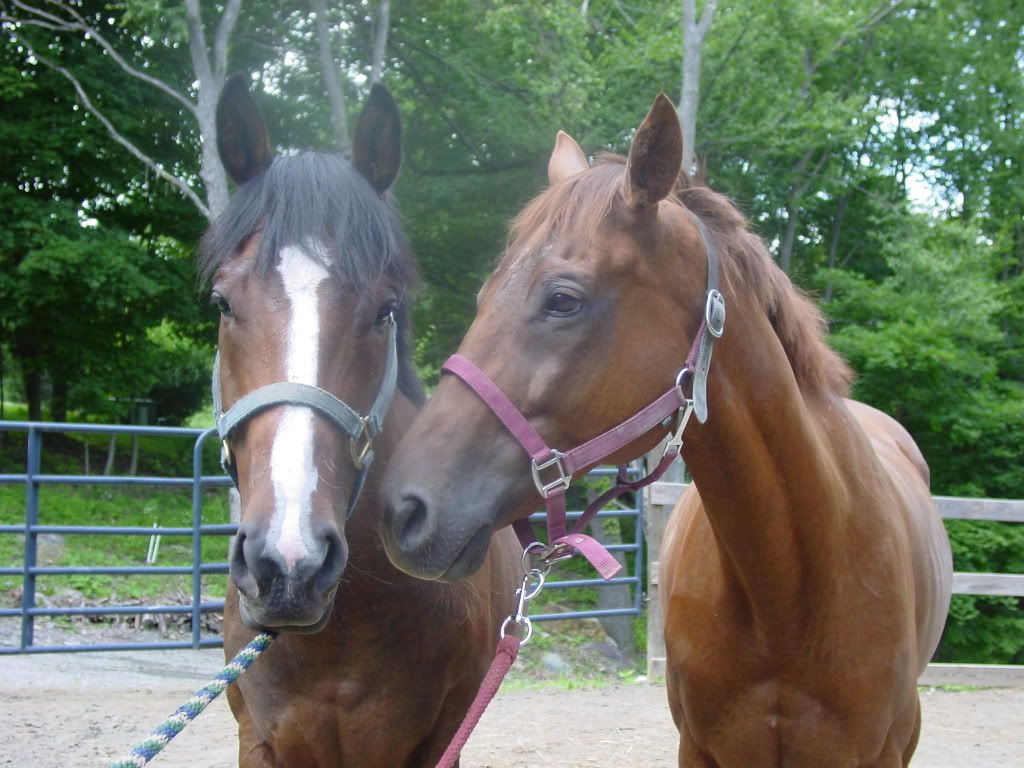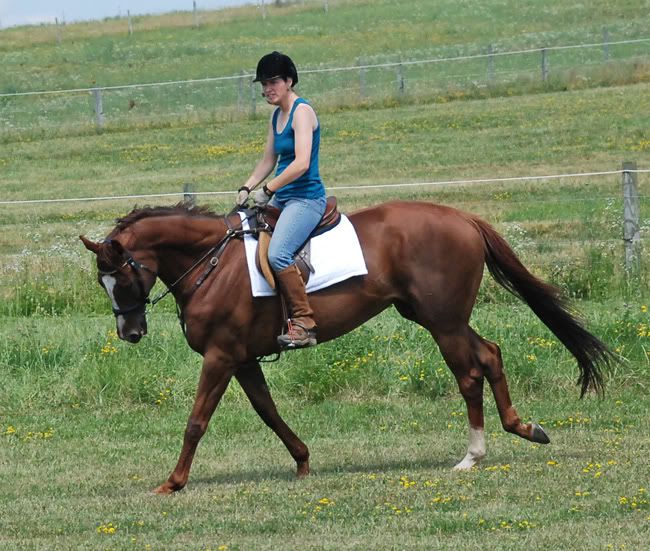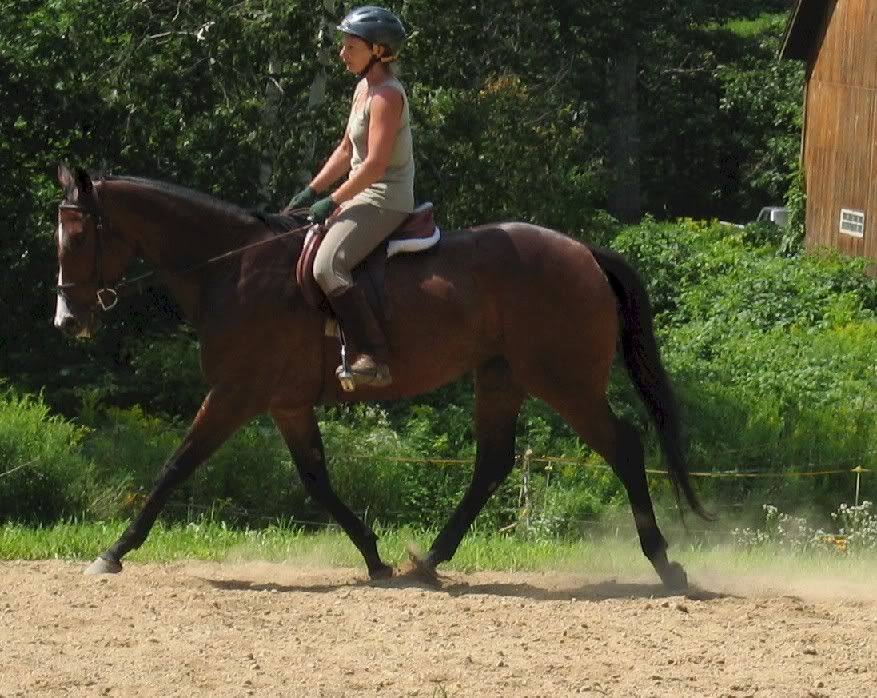|
|
Post by nybabyz on Nov 22, 2008 12:56:09 GMT -5
Even though I've owned horses literally all of my life, I've only had to deal with two abscesses in my life. Both with my current OTTB - she's got those very flat TB feet!
Anyway, about a month ago she came up three legged lame. I was pretty sure it was an abscess so I soaked and wrapped, soaked and wrapped for a couple of days but nothing popped. Vet came out and was able to find what she called "the mother of all abscesses." She had to open a hole in the bottom of her hoof and I swear it seemed like a 1/2 cup of liquid drained out. You could see the immediate relief - my filly almost fell asleep while the vet packed and wrapped her. Anyway, she had antibiotics for 10 days and I soaked and wrapped twice a day and kept the hoof packed with sugar/betadine mix. At the end of the the 10 days her "hole" had filled in quite a bit and she felt good enough that was literally running off the bandage so I stopped wrapping.
Two weeks later she is still tender and limps from time to time. I've not worked her at all and do not plan to until I see absolutely no sign of lameness.
My question is: Is it normal for her to still be tender on that hoof? Mind you she did have a "hole" dug in her hoof - but it looks very filled in. She will run and play and most of the limping that I see is when she turns on that leg, but I have to admit that in the mornings she seems to have some lameness.
Should I have the vet out again? Does she just need more time? Everything else is absolutely normal with her - appetite, alertness, etc.
Thanks for any insight/advice you can give.
ETA: There is no swelling, no heat, no increased pulse - no reaction to touching, poking, prodding, etc.
|
|
|
|
Post by elizabeth_h on Nov 22, 2008 16:09:30 GMT -5
I had something similar happen last winter. Abscess which popped, followed by lingering soreness especially when turning. The vet told me to give it a couple of weeks to resolve the soreness but it stayed. Eventually I had x-rays to see if something else was going on but nothing showed up and the vet suggested I use a pad under the shoe. That did the trick, along with a slight change to the trim. The first pad was a pour-in gel kind, and then he was fine with just a leather pad after that. I think the key is to figure out what is causing the abscess in the first place, and that might help you figure out the next steps.
|
|
|
|
Post by Pam on Nov 22, 2008 18:05:53 GMT -5
Is she barefoot? If so, with flat soles and hard ground, she could just be footsore, expecially if she recently had her shoes pulled.
With a big abcess, it's not uncommon for them to limp for awhile while the sole rebuilds. Also, this time of year with the hard frozen ground here in NY, it's possible that she keeps stepping where it was sore and irritating it again.
Another possibility is that she has a sole bruise, again from the hard ground. A bruise can sometimes cause intermittent lameness because it only hurts when they put pressure where it's sore. That could explain the pain when she turns.
The only thing that doesn't jive with this scenario is the fact that you notice the lameness more in the mornings. Is she stalled at night? If she is consistently sore in the mornings and gets better with movement, that would cause me a little more concern and maybe another call to the vet. If you are happy not riding her though, I would give her another week or even two to make sure she is healed up from the abcess before doing that.
|
|
|
|
Post by jenarby on Nov 22, 2008 20:16:57 GMT -5
Sealy's mother had an abcess that bad. It too 8 weeks before she was finally sound. The vet had also dug a big hole and she did wear shoes. We also ended up putting pads on her that were packed but I honestly can't remember with what. She was sound within a day or two. By the next shoeing we took the pads off and she was fine.
|
|
|
|
Post by nybabyz on Nov 23, 2008 1:10:15 GMT -5
Is she barefoot? If so, with flat soles and hard ground, she could just be footsore, expecially if she recently had her shoes pulled. With a big abcess, it's not uncommon for them to limp for awhile while the sole rebuilds. Also, this time of year with the hard frozen ground here in NY, it's possible that she keeps stepping where it was sore and irritating it again. Another possibility is that she has a sole bruise, again from the hard ground. A bruise can sometimes cause intermittent lameness because it only hurts when they put pressure where it's sore. That could explain the pain when she turns. The only thing that doesn't jive with this scenario is the fact that you notice the lameness more in the mornings. Is she stalled at night? If she is consistently sore in the mornings and gets better with movement, that would cause me a little more concern and maybe another call to the vet. If you are happy not riding her though, I would give her another week or even two to make sure she is healed up from the abcess before doing that. Yes, she is barefoot but has been since I got her over two years ago. That said, she definitely has the flat, thin soles of a typical TB. She's not stalled at night. The horses have a barn that they have access to 24/7 and are fed inside, but it's always open so they come and go as they please. I think I'm giving the wrong impression with my wording that I definitely notice her limp in the mornings. In thinking more about it - that's when I see the horses the most as I feed and watch them while I'm having my morning coffee - so when I notice it. Hubby feeds for me at night because I don't typically get home from work before 7:30pm. I will keep an eye out and if I see any indication that it is more than foot sore, I'll definitely have the vet back. Thanks for your thoughts. :-) |
|
|
|
Post by nybabyz on Nov 23, 2008 1:15:10 GMT -5
I had something similar happen last winter. Abscess which popped, followed by lingering soreness especially when turning. The vet told me to give it a couple of weeks to resolve the soreness but it stayed. Eventually I had x-rays to see if something else was going on but nothing showed up and the vet suggested I use a pad under the shoe. That did the trick, along with a slight change to the trim. The first pad was a pour-in gel kind, and then he was fine with just a leather pad after that. I think the key is to figure out what is causing the abscess in the first place, and that might help you figure out the next steps. Elizabeth, I *think* what caused the abscess is a stone bruise. I had schooled her cross country the Saturday before she came up lame. One area that we had to travel over was washed out and was quite rocky. I tried to pull her up quickly but she did take a few steps that felt ouchy to me so that's part of the reason I was so sure it was an abscess. The other abscess that she had was over 2 years ago, right after I got her. They pulled her racing plates just before I picked her up so I think that coupled with difference in terrain that she was moved to explains that one. Thanks for the thoughts. :-) |
|
|
|
Post by nybabyz on Nov 23, 2008 1:19:49 GMT -5
Sealy's mother had an abcess that bad. It too 8 weeks before she was finally sound. The vet had also dug a big hole and she did wear shoes. We also ended up putting pads on her that were packed but I honestly can't remember with what. She was sound within a day or two. By the next shoeing we took the pads off and she was fine. Thanks. That makes me feel better. I think I'll just give her more time. I'm just a worry wart horse mommy who hates it when they are anything besides 100%. Thanks for responding. :-) |
|
|
|
Post by niaru on Nov 23, 2008 9:11:54 GMT -5
I've never had to deal with an abcess that bad, but I remember Charm was lame for about 2 months at one point, to the point that I took her to the clinic for a full lameness exam with xrays etc, but nothing was found. Vet decided it was a deep stone bruise, and prescribed wedge pads. That did the trick, amazingly. At the next shoeing we just used rim pads (under the shoe).
Around here the trails and ground can get very hard and rocky, and Charm sometimes gets ouchy. In that case I just ask my farrier to put rim pads on her and she's fine again.
Good luck!
|
|
|
|
Post by TeachU2Ride on Nov 23, 2008 16:49:41 GMT -5
Unfortunately, when you have a horse with very thin soles, you often have to keep them shod to keep them sound. I recommend a set of lateral xrays (one of each foot). It will give you a world of info about the internal shape of her feet, which can be a big surprise. If her depth of sole (distance from the bottom of the coffin bone to the ground) is low, shoes and pads may be needed. Otherwise, you may continue the cycle of abcessing, which can lead to other problems (including bone infections). The price of the xrays will be well worth it when you and your farrier know how best to address the situation.
|
|
|
|
Post by niaru on Nov 23, 2008 18:01:04 GMT -5
I forgot to add, maybe your filly would heal better if you keep a boot (such as a EZboot) on for turnout (the ground is so darn HARD these days!) and take it off at night?
|
|
|
|
Post by Pam on Nov 24, 2008 5:53:09 GMT -5
NYB, You're right, a stone bruise can turn into an abcess. Around this area, that's the most common scenario this time of year. I agree with teach though. My two year old doesn't have flat feet at all, but xrays show he has very thin soles. So far he's been fine as far as being ouchy, but my farrier anticipates, and the vet agrees, that he will probalby need shoes once I start riding him and he encounters more that a grass pasture on a regular basis. He also has a very slight misalignment of his P2, which is why we had the xrays done in the first place and so wears his toe down quickly so the shoes will also help with that. He gets his first set in the spring. I feel like a mother buying her kid his first set of walking shoes. (sniff, sniff, my baby's growing up) But I digress. His mother has really flat feet, but her xrays show normal depth of sole and she doesn't have any troubles except on very rocky ground. She hasn't had shoes on in years, stays sound and has never had an abcess except for the time she pulled a shoe and stepped on the clip.  So yes, sole depth is probably more important than concavity. Xrays are really not very expensive and you'll know exactly what you are dealing with for sure. No more guessing.  |
|
|
|
Post by nybabyz on Nov 30, 2008 11:05:46 GMT -5
Just wanted to update everyone who was kind enough to post. My filly is back to 100% - almost TOO much so, the stinker.  Cool weather and a month of no work make for a very....spunky girl.  I did, as recommended, have a complete set of xrays done. Nothing remarkable and the vet thinks that it's fine to leave her barefoot and continue to ride her as I do. One thing that I should have mentioned is that, except for arena and XC work, I typically ride her in EZ Boots. I am just not comfortable running the XC courses in boots - I know some do it, I can't bring myself to try it. Again, thanks to everyone who took time out to give advice. Happy Holidays! |
|









 So yes, sole depth is probably more important than concavity. Xrays are really not very expensive and you'll know exactly what you are dealing with for sure. No more guessing.
So yes, sole depth is probably more important than concavity. Xrays are really not very expensive and you'll know exactly what you are dealing with for sure. No more guessing. 

